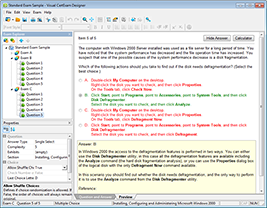The show ip bgp Command
With the show ip bgp command, the entire BGP table is displayed. A list of information about each route is displayed, so this is a nice command to get quick information on your BGP routes.
ISP# sh ip bgp
BGP table version is 4, local router ID is 10.0.0.1
Status codes: s suppressed, d damped, h history, * valid, > best,
i - internal,
r RIB-failure, S Stale
Origin codes: i - IGP, e - EGP, ? - incomplete
Network Next Hop Metric LocPrf Weight Path
*> 10.0.0.0/24 0.0.0.0 0 0 32768 i
*> 10.0.1.0/24 192.168.1.2 0 0 0 100 i
*> 10.0.2.0/24 192.168.2.2 0 0 0 200 i
The output is sorted in network number order, and if the BGP table contains more than one route to the same network, the backup routes are displayed on separate lines. We don’t have multiple routes, so none are shown.
The BGP path selection process selects one of the available routes to each of the networks as the best. This route is pointed out by the > character in the left column.
ISP1 has the following networks in the BGP table:
10.0.0.0/24, which is locally originated via the network command in BGP on the ISP router
10.0.1.0/24, which has been advertised from 192.168.1.2 (R1) neighbor
10.0.2.0/24, which has been advertised from 192.168.2.2 (R2) neighbor
Since the command displays all routing information, note that network 10.0.0.0/24, with the next-hop attribute set to 0.0.0.0, is also displayed. The next-hop attribute is set to 0.0.0.0 when you view the BGP table on the router that originates the route in BGP. The 10.0.0.0/24 network is the network that I locally configured on ISP1 into BGP.
The show ip bgp neighbors Command
The show ip bgp neighbors command provides more information about BGP connections to neighbors than the show ip bgp command does. This command can be used to get information about the TCP sessions and the BGP parameters of the session, as well as the showing the TCP timers and count ers, and it’s a long output! I’ll just give you the top part of the command here:
ISP# sh ip bgp neighbors
BGP neighbor is 192.168.1.2, remote AS 100, external link
BGP version 4, remote router ID 10.0.1.1
BGP state = Established, up for 00:10:55
Last read 00:10:55, last write 00:10:55, hold time is 180 ,
keepalive interval is 60 seconds
Neighbor capabilities:
Route refresh: advertised and received(new)
Address family IPv4 Unicast: advertised and received
Message statistics:
InQ depth is 0
OutQ depth is 0
[ output cut ]
Notice (and remember!) you can use the show ip bgp neighbors command to see the hold time on two BGP peers, and in the above example from the ISP to R1, the holdtime is 180 seconds.
Summary
In this chapter, you learned the difference between the following WAN services: cable, DSL, HDLC, PPP, and PPPoE. You also learned that you can use a VPN once any of those services are up and running as well as create and verify a tunnel interface.
It’s so important for you to understand High-Level Data-Link Control (HDLC) and how to verify with the show interface command that HDLC is enabled! You’ve been provided with some really important HDLC information as well as information on how the Point-to-Point Protocol (PPP) is used if you need more features than HDLC offers or
if you’re using two different brands of routers. You now know that this is because various versions of HDLC are proprietary and won’t work between two different vendors’ routers.
When we went through the section on PPP, I discussed the various LCP options as well as the two types of authentication that can be used: PAP and CHAP.
We then discussed virtual private networks, IPsec, and encryption, and I explained GRE and how to configure the tunnel and then verify it.
We finished up the chapter with a discussion on BGP.



